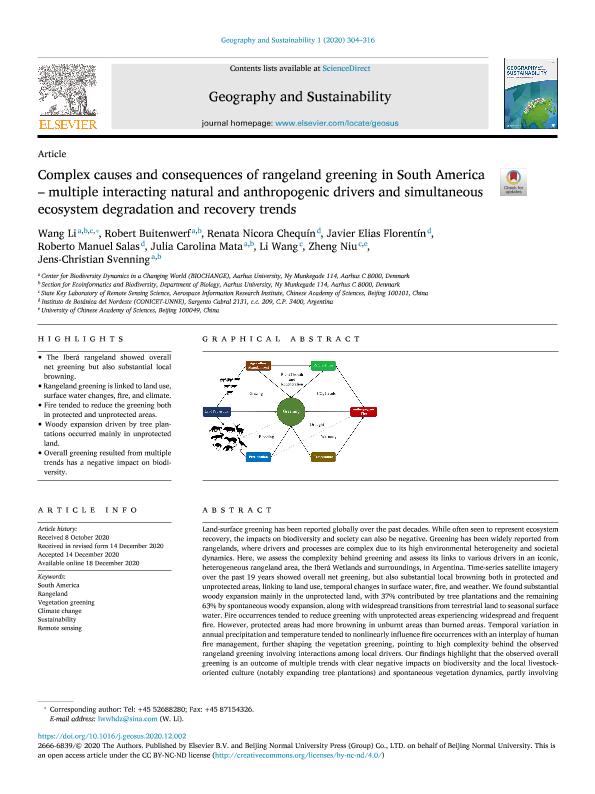Mostrar el registro sencillo del ítem
dc.contributor.author
Li, Wang
dc.contributor.author
Buitenwerf, Robert
dc.contributor.author
Nicora Chequín, Renata

dc.contributor.author
Florentín, Javier Elias

dc.contributor.author
Salas, Roberto Manuel

dc.contributor.author
Mata, Julia Carolina

dc.contributor.author
Wang, Li
dc.contributor.author
Niu, Zheng
dc.contributor.author
Svenning, Jens-christian

dc.date.available
2021-08-13T13:12:48Z
dc.date.issued
2020-12
dc.identifier.citation
Li, Wang; Buitenwerf, Robert; Nicora Chequín, Renata; Florentín, Javier Elias; Salas, Roberto Manuel; et al.; Complex causes and consequences of rangeland greening in South America – multiple interacting natural and anthropogenic drivers and simultaneous ecosystem degradation and recovery trends; Elsevier; Geography and Sustainability; 1; 4; 12-2020; 304-316
dc.identifier.issn
2666-6839
dc.identifier.uri
http://hdl.handle.net/11336/138260
dc.description.abstract
Land-surface greening has been reported globally over the past decades. While often seen to represent ecosystem recovery, the impacts on biodiversity and society can also be negative. Greening has been widely reported from rangelands, where drivers and processes are complex due to its high environmental heterogeneity and societal dynamics. Here, we assess the complexity behind greening and assess its links to various drivers in an iconic, heterogeneous rangeland area, the Iberá Wetlands and surroundings, in Argentina. Time-series satellite imagery over the past 19 years showed overall net greening, but also substantial local browning both in protected and unprotected areas, linking to land use, temporal changes in surface water, fire, and weather. We found substantial woody expansion mainly in the unprotected land, with 37% contributed by tree plantations and the remaining 63% by spontaneous woody expansion, along with widespread transitions from terrestrial land to seasonal surface water. Fire occurrences tended to reduce greening with unprotected areas experiencing widespread and frequent fire. However, protected areas had more browning in unburnt areas than burned areas. Temporal variation in annual precipitation and temperature tended to nonlinearly influence fire occurrences with an interplay of human fire management, further shaping the vegetation greening, pointing to high complexity behind the observed rangeland greening involving interactions among local drivers. Our findings highlight that the observed overall greening is an outcome of multiple trends with clear negative impacts on biodiversity and the local livestock-oriented culture (notably expanding tree plantations) and spontaneous vegetation dynamics, partly involving spontaneous woody expansion. The latter has positive potential for biodiversity and ecosystem services in terms of woodland recovery, but can become negative in such a natural savanna region if expansions develop on a too broad scale, highlighting the importance of ensuring recovery of natural fire and herbivory regimes in protected areas along with sustainable rangeland management elsewhere.
dc.format
application/pdf
dc.language.iso
eng
dc.publisher
Elsevier

dc.rights
info:eu-repo/semantics/openAccess
dc.rights.uri
https://creativecommons.org/licenses/by-nc-nd/2.5/ar/
dc.subject
CLIMATE CHANGE
dc.subject
RANGELAND
dc.subject
REMOTE SENSING
dc.subject
SOUTH AMERICA
dc.subject
SUSTAINABILITY
dc.subject
VEGETATION GREENING
dc.subject.classification
Ecología

dc.subject.classification
Ciencias Biológicas

dc.subject.classification
CIENCIAS NATURALES Y EXACTAS

dc.title
Complex causes and consequences of rangeland greening in South America – multiple interacting natural and anthropogenic drivers and simultaneous ecosystem degradation and recovery trends
dc.type
info:eu-repo/semantics/article
dc.type
info:ar-repo/semantics/artículo
dc.type
info:eu-repo/semantics/publishedVersion
dc.date.updated
2021-04-28T20:05:47Z
dc.journal.volume
1
dc.journal.number
4
dc.journal.pagination
304-316
dc.journal.pais
China

dc.description.fil
Fil: Li, Wang. Chinese Academy of Sciences; República de China. University Aarhus; Dinamarca
dc.description.fil
Fil: Buitenwerf, Robert. University Aarhus; Dinamarca
dc.description.fil
Fil: Nicora Chequín, Renata. Consejo Nacional de Investigaciones Científicas y Técnicas. Centro Científico Tecnológico Conicet - Nordeste. Instituto de Botánica del Nordeste. Universidad Nacional del Nordeste. Facultad de Ciencias Agrarias. Instituto de Botánica del Nordeste; Argentina
dc.description.fil
Fil: Florentín, Javier Elias. Consejo Nacional de Investigaciones Científicas y Técnicas. Centro Científico Tecnológico Conicet - Nordeste. Instituto de Botánica del Nordeste. Universidad Nacional del Nordeste. Facultad de Ciencias Agrarias. Instituto de Botánica del Nordeste; Argentina
dc.description.fil
Fil: Salas, Roberto Manuel. Consejo Nacional de Investigaciones Científicas y Técnicas. Centro Científico Tecnológico Conicet - Nordeste. Instituto de Botánica del Nordeste. Universidad Nacional del Nordeste. Facultad de Ciencias Agrarias. Instituto de Botánica del Nordeste; Argentina
dc.description.fil
Fil: Mata, Julia Carolina. University Aarhus; Dinamarca
dc.description.fil
Fil: Wang, Li. Chinese Academy of Sciences; República de China
dc.description.fil
Fil: Niu, Zheng. University Of Chinese Academy Of Sciences; China. Chinese Academy of Sciences; República de China
dc.description.fil
Fil: Svenning, Jens-christian. University Aarhus; Dinamarca
dc.journal.title
Geography and Sustainability
dc.relation.alternativeid
info:eu-repo/semantics/altIdentifier/url/https://linkinghub.elsevier.com/retrieve/pii/S2666683920300626
dc.relation.alternativeid
info:eu-repo/semantics/altIdentifier/doi/http://dx.doi.org/10.1016/j.geosus.2020.12.002
Archivos asociados
